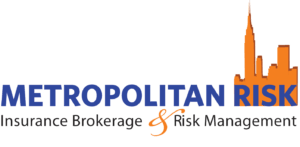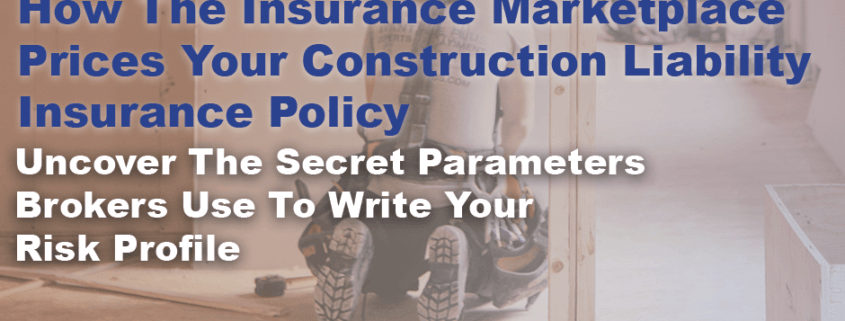Do you want the secret in understanding how the insurance marketplace prices your construction liability insurance policy renewals? This is an instructional piece to be shared with your staff members in charge of assisting in the design and purchase of your insurance program.
Throughout my 30 year career, I have found it especially advantageous to have a clear understanding of what the other side is trying to accomplish, and how they execute. Too often CFO’s and owners of businesses lead with how they “feel” about their company and how the insurance marketplace SHOULD price their account. Often their feelings are far from reality. Here is a primer so you know how to properly position your account, set expectations and beat your competition.
The Parameters Underwriters Use To Build Your Underwriting Risk Profile :
Every good insurance broker should be framing your company’s Risk Profile so you and they control the narrative. The Risk Profile is essentially the main underwriting package or submission the brokerage community makes on your behalf. The goal is to transfer as much risk as possible to the insurance marketplace for the lowest possible premiums. This creates the most value for you the end-user buyer. Too often insurance buyers don’t transfer nearly enough risk, simply jumping at the lower premiums incorrectly assuming the coverage they are getting is equal. THERE IS NOTHING MORE EXPENSIVE THAN A CHEAP INSURANCE POLICY!! PERIOD!
How Do You Make Your Money ?

What the insurance underwriter is trying to understand is what is your “craft” , how do you make your money. In construction, your business model coupled with your means and methods is a very big deal.
If your company does masonry work they need far more detail than simply “masonry”. Are you only doing flatwork, or do you work at heights? If you work at heights; how high to you go up? Whose your end-user client? Condo’s Co-op’s, parking garages, commercial warehouse, municipalities?
How you answer these questions helps both the broker placing the risk AND the underwriter who is deciding what coverage’s to give, what exclusions to put on the policy and how much premium to charge.
We suggest that you have a well thought out descriptive write up about your company in advance which helps build your “Risk Profile”. In the absence of this, you are leaving much to chance as this is not optimal for any stakeholders.
Where Do You Make Your Money ?
Your geographic footprint is very important. Insurance rates and claims experience is VERY local. The local laws really drive claims up or down contingent on the geographic region. Each locale has it’s own challenges and opportunities. Further, many insurance carriers restrict coverage in “hard market” locations where the challenges are acute like all of New York State due to the Labor Law and or “worse” New York City. If your operation is countrywide or international we need to know that too as this affects coverage design and pricing. It’s important you disclose this. Often the carrier wants to know what % of sales come from each geographic region.
QUICK TIP: The higher the Risk Profile, the more risk the insurance carrier takes on which usually means they will charge more premiums in exchange for that risk.
What Are Your Results ?
This is where the rubber meets the road. Our customers at Metropolitan Risk understand the price companies pay for their insurance premiums are a function of how well they prevent and manage their claims. We did a short little video called “What’s the Most Important Metric When Evaluating Your Future Liability Insurance Costs.” If you haven’t seen it in we highly recommend it.
Spoiler alert, it’s about what your loss pic is by line of insurance. Your Loss pic essentially determines how profitable your account has been to the insurance marketplace over the prior 5 years. It’s simple if the carriers lost money on your account, expect a price increase. If they made money on your account you should be fairly flat contingent on the overall market. If the carriers are making a lot of money on your account, you should do really well at renewal. Every company should have its companies most current loss pic at their fingertips at all times. This is a GREAT leading indicator. Your actual insurance renewal is a lagging indicator.
How Many Times Have You Switched Carriers?
This is a simple concept. If your account is on the street every year and your bidding out the insurance annually the underwriters know this. In most markets, there are only a few insurance carriers that have an appetite for your risk profile. Like clockwork, the submission comes in, usually from different brokers. Most insurance carrier underwriter hate this. They see it for what it is. A short term situation whereby they are renting your account for a year or 2 and then you’re off to the next dance partner. After a few submissions like this, the underwriters cease to give your file the consideration it deserves. At Metropolitan Risk we believe this really hurts the company who does this. The brokers don’t care as it’s not their story or reputation.
QUICK TIP: You should not put your account on the street every year. Once every 3 to 4 years is best practice unless you have coverage concerns or problematic exclusions that are jamming you up.
Best Practice Additions :
Here is where most other brokerage’s stop. At Metropolitan Risk we believe these next few additions make a HUGE difference. We have the testimonials to prove it.
A) Company Org Chart :
If your properly staffed with safety personal, in-house legal counsel, HR Admins, Project Managers & Coordinators we encourage you to highlight this. If you’re staffed properly this is a strength of your organization. We believe there is a direct correlation to being properly staffed forward and you lagging claims results. Companies that are staffed thinly tend to have far higher losses.
B) What About Your Company Is Unique?
What are you doing as a company that’s different, unique, special, that sets you apart from your competition? Do you have a competitive advantage in your native market that makes you more competitive, increases your quality or your margins? Let’s talk about this. Those same qualities may help lower your risk profile too. We need to tell that story.
C) Got Claims? :
The carriers are going to see the losses on your claims history so there’s no hiding it. Instead lets’ talk about them. Why they happened and more importantly what changes you have made to make sure they don’t happen again. This is really important as we are asking the underwriter to discount the historical claims performance of the account. We need to give them something of substance here so they can go to management and argue for us as to why the past won’t be prologue.
D) Don’t Just Say; Show It!:
If you’re telling a good story above in B or C back it up. Show some physical evidence to the underwriter you are doing this. Too often both the brokers and the businesses they represent tell a good “story” but it’s a story of fiction at worse, a story of gross embellishment at best. Adding reports, minutes to meetings, something that adds credence that you are actually doing what you say your doing’ that is powerful!
E) Who’s Telling Your Story?
We probably should have lead with this. If you were smart enough to follow the entire submission blueprint above don’t forget the most important part. Have (1) broker submit your application to the marketplace. If your preference is to use two brokers that’s your preference however please be sure to control your story. Nothing is worse than when (1) underwriter gets 2 entirely different submissions from 2 different brokers. You only have (1) shot at a good first impression. We did a great short little video on this called HOLDING ON TO YOUR STORY.
A good underwriter is not going to take the time to figure out which submission is the “correct” one. Instead, both brokers and the company they represent lose all credibility and the underwriter moves on to the next file. The bottom line controls your story. The best way to do that has one broker represent you in the marketplace. IF you don’t trust they will get you the best price and coverage combination, then you have the wrong broker.
If you would like to see what a Best Practices Submission looks like speak with a Risk Advisor by calling (914) 357-8444 or CLICK HERE to Schedule a 5-minute call!










